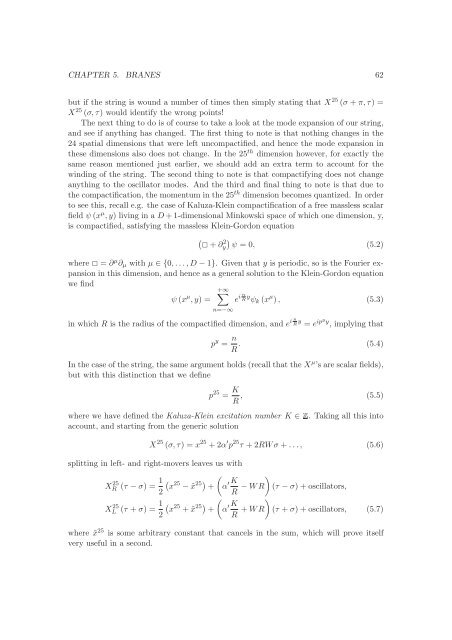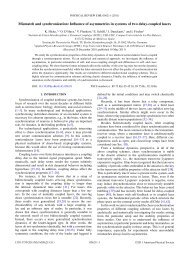DBI Analysis of Open String Bound States on Non-compact D-branes
DBI Analysis of Open String Bound States on Non-compact D-branes
DBI Analysis of Open String Bound States on Non-compact D-branes
You also want an ePaper? Increase the reach of your titles
YUMPU automatically turns print PDFs into web optimized ePapers that Google loves.
CHAPTER 5. BRANES 62but if the string is wound a number <str<strong>on</strong>g>of</str<strong>on</strong>g> times then simply stating that X 25 (σ + π, τ) =X 25 (σ, τ) would identify the wr<strong>on</strong>g points!The next thing to do is <str<strong>on</strong>g>of</str<strong>on</strong>g> course to take a look at the mode expansi<strong>on</strong> <str<strong>on</strong>g>of</str<strong>on</strong>g> our string,and see if anything has changed. The first thing to note is that nothing changes in the24 spatial dimensi<strong>on</strong>s that were left un<strong>compact</strong>ified, and hence the mode expansi<strong>on</strong> inthese dimensi<strong>on</strong>s also does not change. In the 25 th dimensi<strong>on</strong> however, for exactly thesame reas<strong>on</strong> menti<strong>on</strong>ed just earlier, we should add an extra term to account for thewinding <str<strong>on</strong>g>of</str<strong>on</strong>g> the string. The sec<strong>on</strong>d thing to note is that <strong>compact</strong>ifying does not changeanything to the oscillator modes. And the third and final thing to note is that due tothe <strong>compact</strong>ificati<strong>on</strong>, the momentum in the 25 th dimensi<strong>on</strong> becomes quantized. In orderto see this, recall e.g. the case <str<strong>on</strong>g>of</str<strong>on</strong>g> Kaluza-Klein <strong>compact</strong>ificati<strong>on</strong> <str<strong>on</strong>g>of</str<strong>on</strong>g> a free massless scalarfield ψ (x µ , y) living in a D +1-dimensi<strong>on</strong>al Minkowski space <str<strong>on</strong>g>of</str<strong>on</strong>g> which <strong>on</strong>e dimensi<strong>on</strong>, y,is <strong>compact</strong>ified, satisfying the massless Klein-Gord<strong>on</strong> equati<strong>on</strong>( + ∂2y)ψ = 0, (5.2)where = ∂ µ ∂ µ with µ ∈ {0, . . .,D − 1}. Given that y is periodic, so is the Fourier expansi<strong>on</strong>in this dimensi<strong>on</strong>, and hence as a general soluti<strong>on</strong> to the Klein-Gord<strong>on</strong> equati<strong>on</strong>we findψ (x µ , y) =+∞∑n=−∞e i n R y ψ k (x µ ), (5.3)in which R is the radius <str<strong>on</strong>g>of</str<strong>on</strong>g> the <strong>compact</strong>ified dimensi<strong>on</strong>, and e i n R y = e ipyy , implying thatp y = n R . (5.4)In the case <str<strong>on</strong>g>of</str<strong>on</strong>g> the string, the same argument holds (recall that the X µ ’s are scalar fields),but with this distincti<strong>on</strong> that we definep 25 = K R , (5.5)where we have defined the Kaluza-Klein excitati<strong>on</strong> number K ∈. Taking all this intoaccount, and starting from the generic soluti<strong>on</strong>X 25 (σ, τ) = x 25 + 2α ′ p 25 τ + 2RWσ + . . ., (5.6)splitting in left- and right-movers leaves us withXR 25 (τ − σ) = 1 (x 25 − ˜x 25) +(α ′K )2R − WR (τ − σ) + oscillators,XL 25 (τ + σ) = 1 (x 25 + ˜x 25) +2(α ′K R + WR )(τ + σ) + oscillators, (5.7)where ˜x 25 is some arbitrary c<strong>on</strong>stant that cancels in the sum, which will prove itselfvery useful in a sec<strong>on</strong>d.
















